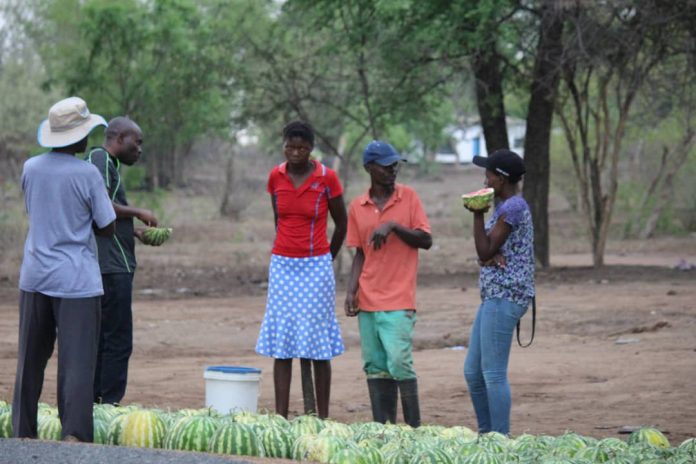By Farai Mabeza
CHIVI-As the droplets of water falling from the sky turn into a steady drizzle a young couple looks dejectedly at dozens of watermelons spread out in front of them, by the roadside along the Ngundu Chiredzi highway.
“It’s worse when it rains. Barely anyone buys them. In dry and hot weather people need the watermelons to refresh themselves and to cool down,” the husband, Talent, reflects. الرالي سيرجيو راموس
Talent and his wife, Panashe, are part of a group of smallholder farmers at Chisase Irrigation Scheme in Chivi. The irrigation scheme draws its water from Tugwi River.
They had managed to produce a healthy crop from a half hectare plot and were gratified by the work of their hands. They did all they knew, from the time of planting to maturity.
But it seems that was as the furthest they could go.
The challenge they face now is how to reap financial dividends from their work.
The roadside market at Chisase business centre is all they have for now. They wish for more, but they have no idea how to get more. It is the marketing side of their trade which eludes them or which they simply cannot master.
“Our biggest challenges are acquiring chemicals and marketing. The melons are our only source of income at the moment after the drought we had last year. At the same time there are so many of us producing them and that pushes the price down.
“Now the rain season has just started and we don’t have proper storage so we end up selling them at giveaway prices because they get damaged in the rain,” Talent says.
“Watermelons need a lot of spraying to protect them from diseases so they are costly to produce. We don’t have the transport to take them where we can fetch better prices,” Panashe adds.
The problems faced by this couple are common among smallholder farmers across the country. يورو 2024
Sometimes it is about lack of access to markets while at times the farmers just don’t do enough research before planting their crops. مسابقات اون لاين In the end, they produce goods which the markets are simply not looking for or don’t need.
The farmers will be hoping that the just launched second Zimbabwe Agriculture Investment Plan (ZAIP 2), the AgrInvest initiative, will provide the solutions that will ease their challenges. العب اون لاين
AgrInvest was launched by the government and the United Nations’ Food and Agriculture Organisation (FAO).
It offers a targeted approach to public and private financing for agrifood system development.
According to official figures, 67 percent of Zimbabwe’s population resides in rural areas. Most of these practice agriculture as smallholder farmers.
Currently 99 percent of the agriculture production structure by land holding is smallholder agriculture. فريق مان سيتي And 72 percent of Zimbabweans are living in poverty with 84 percent of these in the rural areas.
“The most direct route to reducing poverty, hunger and malnutrition in Zimbabwe is rural development through agriculture transformation through the smallholder farmers,” the Ministry of Lands, Agriculture and Rural Settlement acting chief director of Strategic Policy Planning and Business Development, Clemence Bwenje, said.
According to FAO the AgrInvest aims to revamp Zimbabwean agriculture to once again become the bedrock of the economy that generates smallholder farmer inclusiveness, jobs, reduced imports, increased exports, overall trade balance improvement, as well as food and nutrition security.
“The AgrInvest initiative attracts and de-risks private sector investment in agrifood systems and value chains. It builds on FAO’s decades of expertise in formulating, implementing, supervising and evaluating agricultural investment plans, in addition to its policy and legislative advisory role,” the FAO Subregional Coordinator for Southern Africa and Representative to Zimbabwe, Alain Onibon, said.
The investment plan is designed to leverage private investments in agrifood systems by fostering the creation of enabling policies and conducive regulatory conditions to ensure achievement of United Nations’ Sustainable Development Goals(SDGs).
AgrInvest will create solution-oriented platforms for a structured public-private dialogue, promoting relations of trust and evidence-based monitoring of results.
“The FAO has the right mix of knowledge and tools to push for responsible, SDG-compliant investments,” Onibon said.
AgrInvest consists of two intertwined streams; technical analysis that inform effective public private dialogue.
The plan will rebuild local institutions both in the public and private sectors to sustainably hold critical functions.
One of the strategies to be employed will see the usage of public resources to promote private sector led investments into developing productive infrastructures (such as irrigation, mechanization, processing plants…) and commercial infrastructure (feeder roads, market hubs, storage capacity…).
Among the expected results the implementers want to see in-depth analysis of selected agricultural sector based value chains completed with a view to identifying and resolving practical legislative, regulatory and institutional issues.
They want to resolve value chain bottle necks through facilitation and technical support,
starting from low-stake entry points, with provision for the inclusion of sustainable mechanisation and innovation practices.









